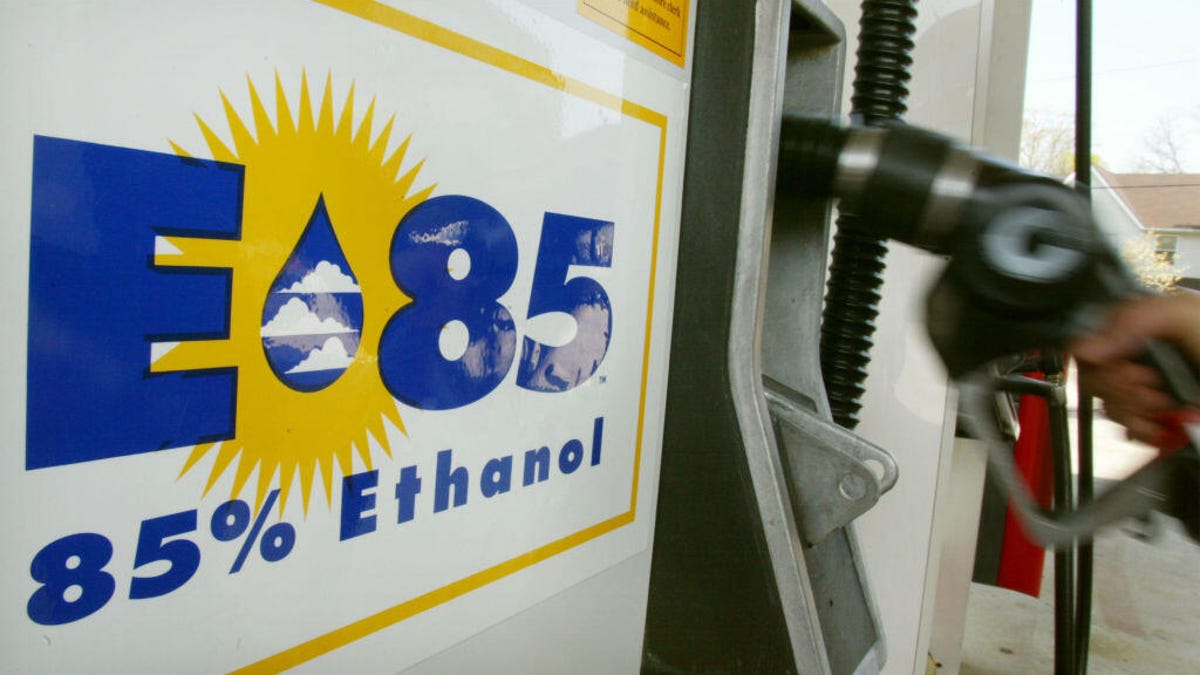Can Your Car Use E85, the Cheaper Gas Alternative?
The ethanol-rich fuel is a cost-conscious option as gas prices rocket. But few cars are able to use it.

E85, a fuel with a much higher ratio of corn ethanol to gasoline, is nearly 30% cheaper than conventional gas.
With gasoline prices continuing to break records, motorists are looking for cheaper alternatives. Iowa Gov. Kim Reynolds has signed a law requiring any gas station built or upgraded starting next year to be compatible with E85, a fuel formulation made with 85% corn ethanol.
E85 is significantly less expensive than regular unleaded: In Iowa, where regular unleaded has hit $4.75, E85 averages $3.42 a gallon
But most cars aren't rated to use corn ethanol-based fuel, and experts say the savings with cars that are designed for it are often swallowed up by poor fuel mileage.
"Anything you'd save at the pump, you're going to lose driving your car," John Schupp, owner of Missouri auto repair shop Sci-Tech Automotive, told KMBC in Kansas City.
Here's what you need to know about E85, including how to know if your car can use it, whether it's truly cheaper and what impact it has has on the environment.
What is E85 fuel?
Most formulations of gasoline are E10, or just 10% corn ethanol and 90% gasoline. E85, also called flex-fuel, is a blend of 85% ethanol to 15% gasoline.
Is E85 cheaper than regular gasoline?
Per gallon, E85 is almost always significantly less expensive than regular gas: The national average for regular unleaded on Tuesday was about $5.02. For E85, it was only $3.67.
In California, where gasoline has reached a nationwide high of $6.44, E85 averages $3.60. In Oklahoma, you can find it for as little as $2.89 a gallon.
But flex-fuel vehicles, or FFVs, using the high-ethanol blend have much lower fuel efficiency, Kelly Blue Book reported. In some cases, the difference in mileage is nearly 25%.
As an example, the automotive research firm said, a 2021 Ford F150 pickup could get 21 combined miles per gallon when using gasoline, but only 16 mpg filled with E85.
With a price differential of nearly 30%, or even greater in some areas, it may be worth it for many drivers. In addition, E85 has a higher octane content, which can produce more power in engines designed to use it.
How do I know if my car is rated for E85?
If your automobile can accept E85 fuel, it should have a yellow gas cap, or, if you have a capless fuel filler, a yellow ring around the hole where the nozzle is inserted.
A badge reading "Flex-Fuel," "FFV" or "E85" on the back of the vehicle may also indicate compatibility, according to Kelly Blue Book. And you can always check your owner's manual.
According to market data firm IHS Markit, there were at least 21 million FFVs in the US in 2017, the most recent year for which information was available.
But rising interest in electric vehicles has seen a move away from E85-rated autos. Last year, only Ford and General Motors produced flex-fuel vehicles, and they made only 11 models. That's a serious decrease from 2015, when there were 80 different models from eight carmakers that were rated for E85, according to the Renewable Fuels Association.
E85 fuel has a mixture of 85% corn ethanol to 15% gasoline.
Can I fill up on E85 even if my car isn't rated for it?
While some motorists are tempted to use E85 in a car designed only for conventional gas, or to top off their tank with it, "unless you're driving a vehicle specifically made for the cheaper fuel, using it can cause engine damage," according to Consumer Reports,
"You'll probably have a tow truck taking it to the shop because, after about two tanks of E85, a car that's not equipped for it probably won't run," Schupp told KMBC.
Where is E85 sold?
According to E85Prices.com, there are more than 5,500 gas stations selling E85 flex-fuel, mostly in eastern states, the Midwest and California.
That works out to slightly less than 4% of all retail gas stations in the US.
Is E85 better for the environment?
A 2019 study by the US Department of Agriculture said corn-based ethanol is much cleaner than petroleum, with 39% fewer greenhouse gas emissions.
But a report published in February by the Proceedings of the National Academy of Sciences factored in the cost of land and water use and determined that ethanol leaves a much larger carbon footprint. The carbon intensity of corn-based fuel is "likely at least 24% higher" than that of conventional gas, the researchers said.
Fuels with higher ethanol content, like E15 -- which contains 15% ethanol and 85% gasoline -- are usually prohibited during the summer because it's believed they contribute to smog levels. (Traditional fuel is 10% ethanol and 90% gasoline.)
But in light of the current fuel crisis, the Biden administration has lifted the summertime ban.
Currently, the limited scale of corn ethanol production means it's unlikely to impact climate change much either way. But that could change if demand increases or government regulations mandate that a higher percentage of fuel come from renewable sources.

